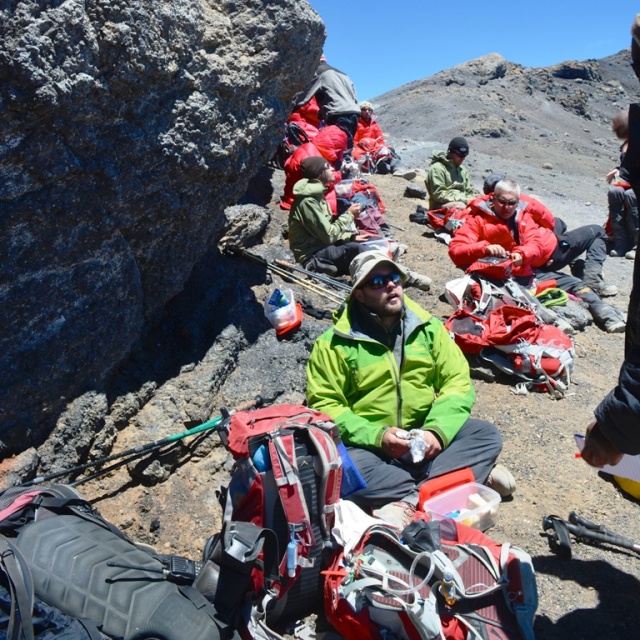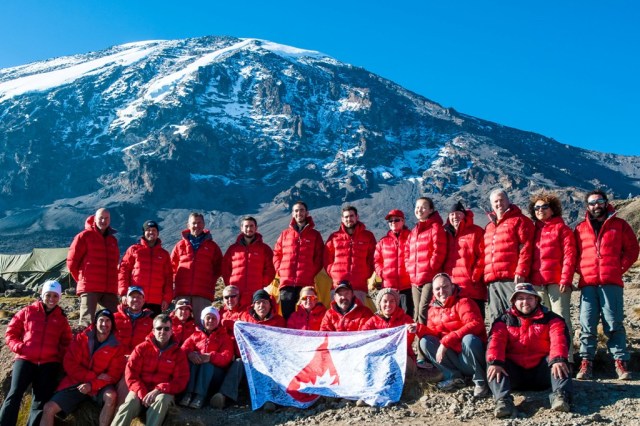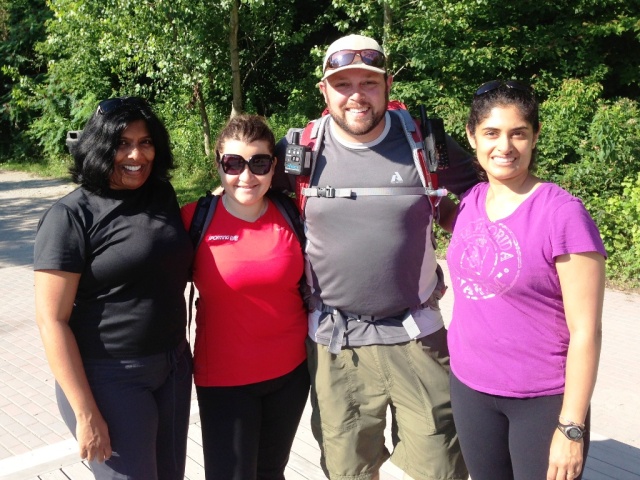This is Part 3 in a series of articles about the #Climb4Cord. Read Part 1 and Part 2…
– – –

The first #Climb4Cord group reaches the summit of Mt. Kilimanjaro just before 2pm local time on August 12th, 2013. (Credit: Graham Sher)
We were a few hundred meters from the summit of Mt. Kilimanjaro when the tears started to flow. Derek, Urio, Christopher and I were on the heels of the first group, which was about to reach the summit. It was just before 2pm local time. Just as Eddie Frank had planned.
The ground had flattened out. I no longer felt tired. In fact, I felt like I was walking down Yonge Street back in Toronto. I was tempted to run towards the infamous green sign I had envisioned reaching during so many months of training. But I held myself back, wanting to soak in each and every second while thinking about all the people in my life who had helped me get to this point in time. I envisioned how proud my wife, my kids, my family, my friends would be.
Moreover, I thought about my dad. The man who had such an influence on the person I am today. He was the man who taught me to treat others with respect, no matter who they were. The man who would sit and listen to every single one of my CFL radio broadcasts and then call me on my way home from the stadium to rehash the entire game, pointing out instances where I could have been better. The man who would wake up at 5am on a Saturday morning to take me to hockey practice before I could drive. Afterward, he would sit with me at the local White Spot and recap every single play I had made on the ice, while we wolfed down our breakfasts.
I imagined what our conversation would have been like had he still been alive. The stories I would share with him of Kilimanjaro – of how 25 of us came together in an attempt to make a difference in the lives of all Canadians.
I took off my sunglasses to wipe away the tears. By now, salt stains lined the plastic rims as each tear dried quickly from the harsh midday sun and dry alpine air.
By the time I reached the sign, it was chaos.
I was fired up beyond belief. I started hugging everyone in sight as the emotions of months of training and days on the mountain were released. I felt like the weight of the world had been lifted from my shoulders at that exact moment. I felt relief.

Jaime Stein and Graham Sher hold up the official Canadian Blood Services flag at the summit of Mt. Kilimanjaro. (Credit: Graham Sher)
Summit morning had arrived quickly. Firstly, it was difficult to sleep at high altitude. The air was thin at Barafu Camp, which stood at 14,950-ft (4,556-m). Secondly, we had to wake up at 3:45am, so sleep was scarce to begin with.
It was bitter cold when Derek Amery and I woke up. It was a struggle to move through camp due to the darkness and steep, rocky footing. Making our way to the washroom was a chore. Tying our boots was excruciating. Even eating breakfast was a challenge. We drank as much tea as possible to try and warm our bodies up.
In an effort to get everyone from the #Climb4Cord team on the summit at the same time, the last group became the first group on the morning of August 12th. It was growing, too, as more people started to feel the effects of the altitude. As usual, I was hiking with Derek, but we were joined by Andrea Frenk and Daniel Schustermann. We were also assigned two out of the five guides as a precaution because we had a greater risk of getting ill. This would entail abandoning our climb and descending back to Barafu Camp.
It was eerily silent as we assembled outside the mess tent. The sky was clear. You could see so many stars – it was like the planetarium back home. And you could see the vapour of each breath through the beam of your headlamp – breathing at this altitude was no easy chore.
But most of all, it was cold. So cold that we spent two to three hours hiking in our parkas – a prospect I had laughed at when the big, bulky red down garment arrived at my house in Toronto on a 35-degree summer day.
We were also hiking with our headlamps on for the first time, on one of the most technical parts of the entire climb. We walked in a line. Slowly. One foot after the other, following the cadence set by the lead guide. There was little talking as we focused on each step and each breath.
The frigid morning was but a distant memory as I jumped around the summit, oblivious to the fact that I was now at 19,341-ft (5,895m). The adrenaline gave me strength and energy that I wouldn’t have believed possible just four days prior when altitude sickness nearly ended my climb prematurely. I was a new man.
I fired off a couple of Tweets via our Delmore inReach satellite tracking device to let the world know that we had arrived. I knew that people back home had been watching our dotted trail snake up the online map with a mix of excitement and concern.
Not long after reaching the summit we started taking photos. Dr. Graham Sher, who happens to be an incredible photographer in addition to leading Canadian Blood Services (CBS), pulled out his DSLR and fired away. I posed for some individual photos with my fists and poles in the air. I was jacked up from the euphoria of the moment. I meant to write a checklist on my arm of the photos I needed to take, just in case my memory wasn’t 100 per cent. But somehow I managed to get everything I needed, including some additional pictures with my ING DIRECT #OrangeScarf. (ING DIRECT was a sponsor of the climb)
Then I posed for a shot where I held up a photo of my dad from his 60th birthday party – one of the last times our family was together before he died. I started crying uncontrollably while Graham snapped away. I’m glad he was able to capture that moment. It meant a lot to me.
After shooting some group photos with the CBS flag, I removed my outer shell as I was actually starting to get hot. The sun was quite strong at this point in the day.
I managed to complete my final task. I recorded a short thank you video for my supporters, before finally standing back and enjoying the moment.

Holding a photo of my dad, Dr. Howard Stein, at Uhuru Peak on Mt. Kilimanjaro. (Credit: Graham Sher)
I’ve been asked multiple times how long I spent on top of Kilimanjaro. The trouble with being on the summit is that you lose track of time. I had been prepared to spend about 20 minutes on top before heading back down. That seemed like the average time groups spent up there based on my research. Only recently, using the time stamps on my photos, was I able to calculate that I was up there for about 45 minutes in total.
While I was feeling like a million bucks, other climbers who had exhibited no signs of suffering the entire trip, started to develop some serious headaches. As a result, Urio had to lead these climbers down immediately. I was left with the option of descending with this group or waiting for the next group to arrive and then head down with them.
I was being encouraged by Eddie to head back down with Urio, who had been my guide and saviour the entire trek, but I wasn’t ready to get off that mountain. I wanted more time on the summit and I was feeling great, so I stayed.
The road to the summit can be split up into a few zones. The first is the rocky cliffs from Barafu Camp to Kosovo Camp. From there it is a long and arduous trek on steep and unstable terrain to the rim of the crater, known as Stella Point. At Stella Point there is a quick break for lunch and then a final push on firmer and less steep ground.
My former colleague Chris Cuthbert had climbed Kilimanjaro a few years ago. In advance of my departure for Africa, he provided me with some valuable advice for summit day. He had told me that if I could make it to the crater rim, the final hour or so would be easy in comparison. If I was feeling exhausted at this point, his advice was to take a break and regain my energy; not to turn around like so many other people who attempted Kilimanjaro have elected or been forced to do in the past.

Looking back down towards the final incline to reach Stella Point from the edge of the crater rim. (Credit: Robin Hibberd)
So my goal that morning was to haul ass to Stella Point and ensure that I had a legit shot at the summit.
An hour or so past Kosovo Camp the sun began to appear on the horizon and we started to warm up. This was a blessing, because hiking in a parka wasn’t very comfortable. It restricted movement, which in turn made it hard to stay in rhythm while walking in a line with the group.
The entire morning was about rhythm and focus on the next step so that you didn’t lose any momentum. The trail was very steep and the footing was soft – almost like sand.
Eventually, our group split into two because Derek and I were able to go at stronger pace than the others. We charged ahead along with Urio and Christopher towards Stella Point – two steps forward, one step sliding back in the scree.
Eddie had shared with us his dislike for the final couple of hours up to Stella Point because it feels like you will never reach the crater rim due to the illusions of the slope of the mountain. But I felt fresh. All the hours of leg training with Marshall were kicking in – walking stairs in a 40-lbs. weight vest; leg pressing 500-lbs. 20, 30, even 40 times. My time in the gym was paying off.
I was so energized in the final stretch towards Stella Point that I blasted past Urio to get there. I had a huge smile on my face and I high-fived Derek. Some of our porters were already up there lounging on the rocks and they shouted out some cheers of congratulations to us.
We took some photos at the sign (which looks almost identical to the summit sign), but I couldn’t figure out where the summit was. I kept looking across the crater trying to find it. Finally, I realized Uhuru Peak was to my left and it was SO CLOSE!!
I had been warned by Neal Kushwaha – who served as a mentor to me for this climb – not to make the summit my goal. Not to channel all my energy towards reaching the top. He strongly suggested that I view the summit as a midpoint to ensure that I had enough strength and energy to get back down the mountain. His advice was sound, but it became hard to follow with each upward step and my emotions taking over.
If you read many of the tails of disaster on Everest – which I became obsessed with during my preparations, including Jon Krakauer’s Into Thin Air – most people tend to die on the descent because they make terrible decisions in pursuit of reaching the summit. Generally, this leaves climbers without enough oxygen or energy to get back down. Not that I’m comparing Everest to Kilimanjaro by any stretch, but I had made it a goal to be conscious that I didn’t push myself too hard to reach the summit at all costs.
We sat down to eat a boxed lunch at Stella Point. It was still just me, Derek, Urio and Christopher.
Urio checked my oxygen saturation levels and they were low. Down to 73 per cent in fact – the same level they were at when I had arrived at Moir Camp on Day 3. He decided to administer oxygen while I ate my lunch. By then, the next group had arrived at Stella Point and we all started cheering. Unfortunately, I was vigorously tapped on the head by an overzealous climber and as a result started getting a headache.
Eddie was part of the second team to reach Stella Point and he told his group that it was better to keep moving and not to sit for too long while eating lunch. Not wanting to fall too far behind the lead group, I had Urio rip my oxygen off. I sprung up and we took off after them. My adrenaline was pumping and I wasn’t going to be denied reaching the top, especially when I could summit with the first group, which would end up having 11 of the 25 climbers together. It was clear, now, that we would likely be summiting in three groups.
The final hour was awesome. The path was much easier to walk on and the scenery was spectacular. To the right was the crater. To the left were ancient glaciers. And if you looked back, there was a sea of clouds with stunning views of Mawenzi, the Kibo Saddle and the plains below. In my mind, I was feeling the satisfaction of having made it to the top of Africa.
After spending 20 minutes or so on top of Kilimanjaro, the second group arrived. This set off another round of hugs and tears. One of the best moments for me was watching Robin Hibberd and his daughter Sydney embrace on the summit. They were as close to family as I had on the trip. We had spent dozens of hours training together back in Toronto and we generally hung out and ate meals with each other on the climb. That moment also made me wish that my dad was with me.
Soon, it was time for our group, the second group, to make its way back down. More people were starting to feel the impact of the altitude and it was approaching 3pm, which meant that it would be getting dark shortly. We wanted to avoid the last hour of our descent taking place in the dark as we had to retrace our steps over the rocks on our return to Barafu Camp.
It was in the first minutes of our descent that one of the best moments of the climb occurred for me. The third and final group was approaching the summit as we passed them on the way down. Both groups stopped and started hugging each other. That moment of camaraderie solidified what this trip was all about. What a team. What an accomplishment.

Hugs for everyone! Members of the first and second groups descend from the summit while the third group continues to make its way up to the top.
Neal wasn’t kidding when he said to save some energy to get back down the mountain. Going up a mountain allows you to control your momentum and your pace. On the downhill, you are at the mercy of gravity. Especially when dealing with the sandy scree and steep slopes presented by Kilimanjaro. The hike back to Barafu Camp was exhausting. Quadriceps throbbing with each step. Blisters starting to boil beneath toes.
The battle to make it back to camp was gruelling. Water was running low for some people; snacks were becoming scarce for others. As the sun started to go down, a chill set in. We had been hiking for close to 14 hours and nothing can really prepare you for that kind of day.
Six of our 25 team members – those who had exhibited no signs of altitude sickness on the entire climb – spent the night in the crater. They were the only people in the world on that day sleeping at 18,700-ft (5,600-m). They even played hockey to try and establish a world record for the highest hockey game played on earth.
On the eighth day, we headed down to Mweka Camp at 10,400-ft (3,170-m). I figured life was good at this point, but Kilimanjaro has a way of messing with you. Just when I finally felt that I had conquered the mountain, she struck back one final time. With about 30 minutes remaining in our descent to camp, I crashed. Big time. I tried to keep going, but I couldn’t. With the help of a couple of guides carrying me under each arm, I eventually stumbled into Mweka.
“How many lives do you have?” said Dr. Neil McGee as I wobbled down the trail towards camp. This was a fight I wasn’t going to lose.
I collapsed into my tent and nearly passed out. A few moments later, I was jolted back to life thanks to a warm cup of tea loaded with honey. The guides continued to check on me for the remainder of the evening and night. They brought me heaping plates of food and forced me to eat every last mouthful. This helped.
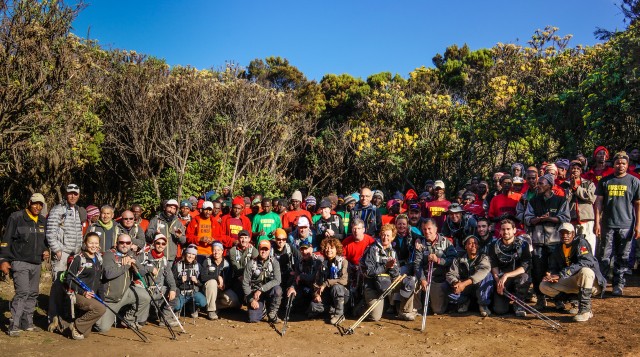
One final team photo, at Mweka Camp, on the morning of our last day on Mt. Kilimanjaro. (Credit: Graham Sher)
By daybreak on our final day on the mountain, I was feeling refreshed. The food and the sleep helped a ton. However, all I wanted to do at this point was get off the mountain and return to Bristol Cottages. The four hour trek to the Mweka Gate was beautiful. The gorgeous rainforest helped take our minds off the pain in our legs.
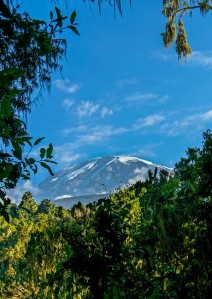
A look back up at the peak of Mt. Kilimanjaro from the trail below Mweka Camp. (Credit: Graham Sher)
I mostly hiked with Derek and Dr. Tanya Petraszko – the three of us had formed a strong bond and we shared some laughs on the way off the mountain. I was fortunate to have Derek as my roommate, tent mate and hiking partner. Without him, I’m not sure I would have made it to the summit.
We rounded the bend towards the base of the mountain and the sounds of a band filled the air. Eddie had arranged for a local band to welcome us and it was quite a scene. The band played for what seemed like an eternity and we ate samosas and drank bottles of Coke.
We had accomplished our goal. All 25 members of the #Climb4Cord team summited Kilimanjaro and made it back down to tell the tale. We also raised more than $350,000 dollars – surpassing our goal by more than 40 per cent.
The drive back to Bristol Cottages was about an hour and the band played the entire way while sitting in the back of a pickup truck. Even back at the cottages, the band continued to play. We hugged. We cried. I connected with both my wife and mom through FaceTime to show them the scene. They cried, too.
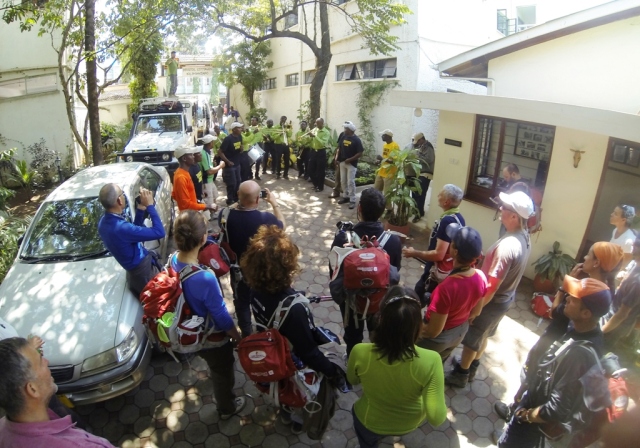
The party continued back at Bristol Cottages as the band played on and on and on! (Credit: Robin Hibberd)
Since returning home to Canada, I’ve been asked: “What’s next?”
Oddly, I want another shot at Kilimanjaro. I want to do it on my own terms. Not sick, not weak, not with the aid of doctors and oxygen. This is the first time that I’ve shared this on a broad scale and it may sound a little crazy, especially given that roughly 60 per cent of people who attempt Kilimanjaro never make it to the top. This includes plenty of world class athletes.
However, as I look back through the photos others have shared from the trip, I feel like I missed out on too many moments and so many of the little details. I want to go back and experience these moments. I want the full experience.
It was an accomplishment I will never forget, but a small void remains in my heart.
This is Part 3 in a series of articles about the #Climb4Cord. Read Part 1 and Part 2…
– – –
The #Climb4Cord featured a group of business leaders who climbed Mt. Kilimanjaro in August 2013 and raised more than $350,000 in personal donations for the campaign For All Canadians, which is dedicated to building Canada’s new national public cord blood bank. Click here to donate to the campaign For All Canadians or for more information on the campaign please visit: http://campaignforcanadians.ca/




